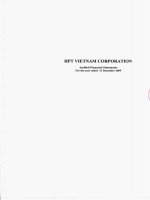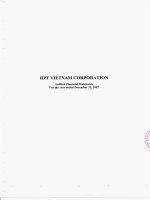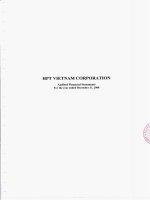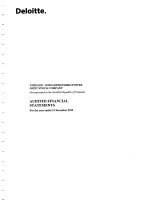INTERNSHIP REPORT TOPIC COMPLETE THE AUDIT PROCESS FOR THE ITEM COST OF GOODS SOLD AUDITED FINANCIAL STATEMENTS AT THE FAT AUDITING AND FINANCE COMPANY LIMITED
Bạn đang xem bản rút gọn của tài liệu. Xem và tải ngay bản đầy đủ của tài liệu tại đây (10.75 MB, 111 trang )
DUY TAN UNIVERSITY
INTERNATIONAL SCHOOL
INTERNSHIP REPORT
TOPIC
COMPLETE THE AUDIT PROCESS FOR THE ITEM COST OF GOODS
SOLD AUDITED FINANCIAL STATEMENTS AT THE FAT AUDITING
AND FINANCE COMPANY LIMITED.
MENTOR
: DR. HO TUAN VU
STUDENT
: NGUYEN THI BICH NGOC
CLASS
: K24 PSU KKT
ID NUMBER
: 24202605009
Da Nang, May 2022
DUY TAN UNIVERSITY
INTERNATIONAL SCHOOL
INTERNSHIP REPORT
TOPIC
COMPLETE THE AUDIT PROCESS FOR THE ITEM COST OF GOODS
SOLD AUDITED FINANCIAL STATEMENTS AT THE FAT AUDITING
AND FINANCE COMPANY LIMITED.
MENTOR
: DR. HO TUAN VU
STUDENT
: NGUYEN THI BICH NGOC
CLASS
: K24 PSU KKT
ID NUMBER
: 24202605009
Da Nang, May 2022
ABSTRACTS
Research problem
• Research on general theory on auditing cost of goods sold item in the financial
statement audit process
• Describe and analyze the actual status of the audit of the cost of goods sold item in
the audit process of financial statements performed by FAT Finance and Auditing
Co., Ltd.
• Proposing solutions to improve the audit of cost of goods sold items in the audit of
•
financial statements performed by FAT auditing company.
Research Methods
Researching audit records and audit program at FAT Auditing and Finance Co., Ltd.
Learn the actual process by interviewing some of the company's auditors.
Collect data from auditors directly at the client company.
Research Objectives
Systematize the theory of the process of auditing cost of goods sold items in the
•
audit of financial statements;
A practical study on the process of auditing cost of goods sold items in the financial
•
•
•
statement audit period at FAT, performed at a specific enterprise to point out the
advantages and disadvantages towel; identify the difference between theory and
practice on the research problem;
• On the basis of theory and practice of the research problem, make assessments and
propose some recommendations to contribute to perfecting the process of auditing
cost of goods sold items in the audit of financial statements financial statements of
the company FAT;
Objects and Scope of Research
• Research object: Process of auditing cost of goods sold item in financial statements
audit at FAT
• Research scope: Researching the application of the fixed asset audit process in the
audit of financial statements at FAT
DISCLAIMER
I certify that the attached thesis is my original work. No other person’s work
has been used without due acknowledgement. Except where I have l clearly stated
that I have used some of the this material , it has not been presented by me for
examination in any other course or subject at this or any other institution.
I understand that the work submitted may be reproduced and/or communicated
for the purpose of detecting plagiarism. I understand that should this declaration be
false, I am libel to be penalized under the Duy Tan University regulations.
Signature:
Date:
ACKNOWLEDGMENTS
First of all, I would like to thank the teachers of Duy Tan University,
especially the teachers of the School's International Education Faculty, for the
change in the teachers of Duy Tan University let me practice to complete the
graduation thesis. And I would also like to thank Mr. Ho Tuan Vu for
enthusiastically guiding me to complete the internship well.
Having obtained this internship report, I would like to express my sincere and
deep gratitude to FAT Auditing and Finance Company Limited, the auditors of the
Financial Statements. The company has directly guided and helped me throughout
the research and completion of the report.
During the practice, as well as during the implementation of the
implementation report, it is difficult to avoid errors, we hope the teachers will
ignore it. At the same time, due to the limited theoretical level as well as practical
experience, the article cannot avoid the shortcomings, we hope to receive comments
from teachers and teachers so that I can learn more experience and will better
complete the upcoming professional article.
Thank you sincerely!
Da Nang, date of 2022
Nguyen Thi Bich Ngoc
TABLE OF CONTENTS
LIST OF ACRONYMS
Management assertion
A=
Accuracy
C=
Completeness
Classification =
Classification
E=
Existence
O=
Occurrence
Acronyms
Full name
BCKiT
Audit report
CĐKT
Balance sheet
BCKQHĐKD
Income Statement
Bảng CĐSPS
Balance sheet amounts arising
BCTC
Financial report
BGĐ
Board of manager
BQT
Board
CMKiT
Auditing standard
CMKTM
Sample audit standards
CP
joint stock company
GVHB
Cost of goods sold
GLV
Working Paper
KSNB
Internal control
KTV
Auditor
TSCĐ
Fixed assets
TK
Account
TNHH
Limited Liability Company
VACPA
Sample audit program
SPDD
Unfinished products
DTT
Net sales
HTK
Inventory
P&D =
Presentation and explanation
R&O =
Rights and obligations
V=
Evaluate
LIST OF TABLES
LIST OF FIGURES
Diagram 1.1. Cost of sales Accounting
Diagram 1.2. Cost of sales Accounting
Diagram 2.1: Organizational chart of FAT
INTRODUCTION
In the market economy, auditing becomes the essential need for production
and business activities and improves management quality of all types of businesses.
Auditing brings honest, reasonable, objective and highly reliable information on the
financial statements. Auditing activities not only create confidence for those who
are interested in the financial situation of the business, but also provide professional
guidance and also reinforce the accounting and financial practices to improve
business efficiency for the units. audit.
Until now, financial statements have always been the main object of
independent audit. Financial statements are a mirror that reflects the results of
operations as well as all aspects of the business production process. This requires
that the information on the financial statements always ensure truthfulness and
reasonableness.
On the enterprise's financial statements, the cost of goods sold is one of the
extremely important metrics that determine the existence and development of a
business enterprise for profit purposes. For a successful business, business results
must be profitable. To make profitable business results, of course, it is necessary to
think about competitive advantage (market dominance), in which cost of goods sold
is always one of the strategic factors. Enterprises always find ways to minimize
(reasonably) this kind of cost. All plans and strategies for buying, selling,
distributing, and supplying are outlined around cost of goods sold. Because the cost
of capital is low, it is possible to lower the selling price, stimulating the buyers. If
the cost of capital is low, the difference between COGS and selling price is high,
and businesses can get more profits.
Because of receiving the importance of cost of goods sold item and the risks
related to cost of goods sold item, I chose the topic: “Auditing cost of goods sold
item in account report audit FAT Auditing and Finance Company Limited performs
for ABC customers ”.
10
The content of the thesis consists of 3 main chapters as follows:
Chapter 1: Rationale for auditing COGS items in auditing Financial
statements under the sample audit program issued by VACPA in 2019.
Chapter 2: Auditing status of COGS item in auditing Financial statements
performed by FAT Auditing and Finance Company Limited.
Chapter 3: Solution for completing COGS item in auditing financial
statements implemented by FAT Auditing and Finance Company Limited.
11
CHAPTER 1
THEORETICAL BASIS OF AUDITING COGS ITEMS IN AUDITING
FINANCIAL STATEMENT UNDER THE SAMPLE AUDIT
PROGRAM ISSUED BY VACPA IN 2019
1.1 BASIC ISSUES RELTED TO COGS
1.1.1 Overview of the COGS item
1.1.1.1 Concept
Cost of goods sold is the cost of finished goods, goods, services or services
provided in the period presented in the income statement..
Or to understand another way: cost of goods sold reflects the cost of products,
goods and services sold in the period, it reflects the consumption of goods as well as
determines the profitability of the business. in one business cycle.
According to Circular 89/2002 / TT-BTC dated October 9, 2002, cost of goods
sold also includes provisions for devaluation of inventory, direct material costs, and
labor costs in excess. unallocated normal and fixed overheads (when operating
capacity is below normal) are not included in inventory, but rather in cost of goods
sold during the period. In addition, this item also reflects loss of inventory after
subtracting compensation caused by personal liability.
1.1.1.2 Features of COGS item
There is a direct and very close relationship between cost of goods sold and
inventory. This relationship makes when the cost of goods sold audit is usually
conducted concurrently with the Inventory audit. When sufficient and appropriate
evidence has been obtained to verify the truthfulness and reasonableness of the
presentation of the inventory item on the balance sheet, the auditor is also
reasonable to withdraw conclude on the truthfulness and reasonableness of the cost
of goods sold on the income statement.
The relationship also shows that, for manufacturing enterprises and
commercial enterprises, inventory always plays an intermediary role in the process
12
of converting the unit's resources into business results. That is also the reason why
the cost of goods sold item is understated and profit is also inflated.
Cost of goods sold is the cost relating to the purchase of goods or the
production of products for sale in a period. Cost of goods sold is determined for
different manufacturing and trading firms. For manufacturing enterprises, cost of
goods sold includes direct raw material costs, direct labor costs and production
overheads that go directly to COGS. Cost of goods sold is the cost relating to the
purchase of goods or the production of products for sale in a period. Cost of goods
sold is determined for different manufacturing and trading firms. For manufacturing
enterprises, cost of goods sold includes direct raw material costs, direct labor costs
and production overheads that go directly to COGS.
Since the cost of goods sold is also seen as an expense, so when auditing the
cost of goods sold item, the auditor is interested in the general standards in cost
accounting, namely:
• Consistency principle: Unifying the use of this period accounting method
with the previous period or the concepts, principles, standards ... applied by the
accounting must be done on a consistent basis in the fiscal year maths. For example:
consistency in recording inventory, recording revenue, expenses ...
• Conservatism principle: ensuring safety in calculating incomes and expenses
in accounting, in particular, income must be sure, expenses must be properly and
fully calculated.
• Matching principle: cost accounting must be the right cost object, in the right
period and in line with the income in the period.
1.1.1.3 The method of calculating the price of inventory
Cost of goods sold is calculated based on the value of inventory sold. Thus, we
classify cost of goods sold based on the method of calculating the cost of goods
sold. We have three methods of calculating the price of inventory as follows:
13
a. Weighted-average
According to this method, the ex-warehousing prices are calculated according
to the average unit price (the average of the whole reserve period, the average at the
end of the previous period, the average after each importation).
Actual price of
exported goods and
Quantity of exported
=
goods and finished
finished products
Average
x
unit price
products
Average unit price is determined in many ways:
•
The average price method for the whole reserve period:
This method is suitable for businesses with few sales points but the number of
times of import and export of products is much, based on the actual price, the
beginning inventory to determine the average price of a product or product unit.
The actual price takes the beginning of
Average unit price of the
reserve period
the period + during the period
=
The actual amount in stock at the
beginning of the period + during
the period
•
Average method at the end of the previous period:
This method is quite simple and timely reflects the fluctuation of raw materials
and goods. However, it is inaccurate because it does not take into account the
volatility of prices.
Actual price costs at the beginning of
Average unit price at the
end of the previous
the period (end of the previous period)
=
Actual inventory at the beginning the
period (at the end of the previous period)
•
-
The average unit price method after each import
This method overcomes the disadvantages of the two above methods, both
accurate and constantly updated continuously.
14
-
The downside of this method is that it takes a lot of effort and calculation
many times.
Average unit price after
each import
=
Actual price after each import
Actual quantity after each import
First in-first out (FIFO)
Goods that are imported first shall be exported first, then all the imported
goods are exported first and then the following imported numbers according to the
actual prices of each exported goods quantity. The ending inventory, therefore, will
be the actual cost of the purchased material in the period.
Appropriate method in cases where prices are stable or in a downtrend.
b. Specific Identification Method
According to this method, which products, supplies and goods are left in the
warehouse of which imported goods, the unit price of that shipment shall be used to
calculate. This is the best option, it complies with the appropriateness principle of
accounting; Actual costs match actual sales. The value of stock for sale in
accordance with the revenue it generates. Furthermore, inventory value is properly
reflected in its real value.
However, the application of this method requires strict conditions, only
businesses with a few types of items, inventories of great value, stable goods and
identifiable inventories. this method can be applied. As for businesses with many
types of goods, this method cannot be applied.
1.1.1.4 Principle of recording COGS
Cost of goods sold is recognized at the same time as revenue. That is, when
the revenue meets the conditions for recognition, the cost of goods sold is also
recognized.
Sales of goods are recognized when all five of the following conditions are
simultaneously met:
(a) The enterprise has transferred most of the risks and benefits associated with
ownership of products or goods to the buyer;
15
(b) The enterprise no longer holds the rights to manage the goods as the owner of
the goods or to control the goods;
(c) The revenue can be measured reliably;
(d) The business has received or will gain economic benefits from the
sale;
(e) Costs related to sales transactions can be determined.
1.1.1.5 Objective and significance of the audit of COGS item on the financial
statement
a. Target:
Cost of goods sold is a large expense in the total cost of the business, it greatly
affects the profitability of the business in the accounting period. Therefore, auditing
cost of goods sold in financial statement audit has the following objectives:
Firstly, to collect evidence to prove whether the internal control system of the
company really guarantees the cost of goods sold in accordance with the provisions
of law, current accounting standards and regimes are not?
Second, collecting evidence to prove that all economic transactions arising in
cost of goods sold have been properly accounted for?
Thirdly, to collect evidence to prove that the arising economic transactions on
the cost of goods sold in the period are real and classified and calculated correctly.
Fourthly, to collect evidence to prove that all economic transactions arising on
the cost of goods sold have been properly documented, valid, legal, properly
recorded and in the correct accounting period or not?
b. Meaning:
Since the cost of goods sold is considered an expense of the business, errors in
the cost of goods sold can lead to errors in the following items, especially taxes to
be paid to the state and benefits. profit of the business. This will affect those who
use the company's financial statements. Auditing the item cost of goods sold to
detect frauds and errors (possible) to adjust to the reality of the unit.
16
1.2 COST OF THE SALES ACCOUNTING
1.2.1 The structure and content reflect the cost of goods sold
Table 1.1 Structure of 632-COGS Account
Debit items
Credit items
For production and business activities,
reflection
Transferring cost of products, goods and
services sold during the period to 911
account "Determination of business
results"
Cost value of products, goods or
services sold during the period.
Transfer all investment real estate
business expenses incurred in the period to
determine business results
Unallocated cost of raw materials, labor Reversal of provisions for impairment of
and factory overheads are included in cost inventories at the end of the fiscal year (the
of goods sold during the period.
difference between the allowance made in
this year is smaller than the amount created
in the previous year)
The loss or loss of inventory after
deducting the compensation caused by
personal liability
The loss or loss of inventory after
deducting the compensation caused by
personal liability
Costs of construction and processing of
fixed assets in excess of normal levels
The reversal of accrued expenses of real
estate is determined to be sold (the
shall not be included in historical cost of
tangible fixed assets that are
selfconstructed or self-completed.
difference between the remaining accrued
expenses and the actual costs incurred).
The amount of provision for devaluation Trade discounts or sales discounts
of inventories
received after purchases are sold
For real estate investment, reflection
Import duties, excise taxes, and
environmental protection taxes have been
included in the value of purchased goods, if
such taxes are refunded when selling
goods.
17
Depreciation of investment property
used for operating lease is deducted during
the period
Expenses for repairing, upgrading and
renovating investment property are not
eligible to be included in the historical cost
of the investment property
Expenses incurred from the operation of
leasing real estate investment activities
during the period
Residual value of investment property
sold or liquidated during the period
Expenses for the sale or liquidation of
investment property in the period
Accrued expense for real estate
considered sold
Account 632 does not have a closing balance
1.2.2 Vouchers and related books
1.2.2.1 Financial report
According to the current accounting regime. Financial statements include the
balance sheet, the report on business results, the cash flow statement and the Notes
to the financial statements and the balance sheet. In the cost of goods sold audit, we
only pay attention to the income statement, the note to the financial statement and
the balance sheet..
Income Statement
Income statement generally reflects the revenues, expenses and production and
business activities of the enterprise for a certain period, including sales and service
provision, financial activities and operations. other movement. On the income
statement we see the value of the revenue from the goods sold and the service
provided, the cost of goods sold for this year and the previous year.
Notes to the financial statements
18
Notes to financial statements are detailed notes of events, arising figures
recorded in the financial statements, in order to help readers understand financial
information more easily about the financial data of the units. The notes on the
financial statements provide us with details of the cost of goods sold for each type
of goods, finished goods and services in the business in this period and the previous
period..
Balance sheet amounts arising
The balance sheet incurred is attached to the financial statements. The arising
balance sheet sums all the arising numbers of all accounts in the accounting period
of the business. The incurred balance sheet provides us with figures of the opening
balance, the amount incurred in the period, and the closing balance of the cost of
goods sold accounts of the business.
1.2.2.2 Accounting books
Accounting books are necessary documents for auditors to use when auditing
at customers. Because data recorded from accounting books are then used to report
to the financial statements. There are many types of accounting books in the unit.
However, to audit cost of goods sold item, the enterprise needs the following books:
-
Ledger, detailed books of accounts 632, 154, 155, 156, 157: are records to
track sales operations and warehousing of goods and finished products for sale.
-
Production cost summary table: Cost of goods sold is composed of various
costs, for example direct labor cost, direct raw material cost, production
overhead in COGS. Thus, collecting a summary of production and business
costs so that the auditor can assess the accuracy of the cost of goods sold..
-
Report on import-export-stock of finished goods and goods: An importexportinventory report provides the auditor with the quantity and unit price of each
type of goods and finished goods imported and exported in the period from
which to help the auditor. Auditors can check the quantity of finished products
and goods exported into the cost of goods sold.
19
1.2.3 Inventory accounting chart
Diagram 1.1. Cost of sales Accounting
(Perpetual inventory system)
20
Diagram 1.2. Cost of sales Accounting
(Periodic inventory system)
1.3 COGS WITH AUDITING ISSUES
1.3.1 Procedures for internal control of cost of goods sold
Find out and evaluate the effectiveness of the internal control system in the
client's company
When entering the audit of financial statements, the auditor and the auditor
should first evaluate the client's internal control system. The study of the customer's
internal control system and the assessment of the control risks helps the auditor
design appropriate audit procedures, assess the volume and complexity of the audit,
from there, the time is estimated and the focus of the audit is determined.
21
The better the entity's internal control system, the better the auditor will
narrow the audit scope, audit time and cost for the audit..
Auditors can conduct surveys of the customer's internal control system in the
following forms:
•Interview company employees
•Review document rotation processes.
•Observe control procedures
Objective of the control test is for cost-of-sales item audits:
Reality: cost of goods sold recorded on the books must be real.
•Content of control: That is, the auditor must consider the recognition of cost
of goods sold based on the delivery note, delivery and delivery record..
•Control procedures: The auditor selects a random sample of cost price
recording operations in the year, compares the delivery note, delivery and
delivery records.
Completeness: Cost prices must be fully recorded.
•Content of control: The notes on the release of goods and finished products
sold must be transferred to the accounting department and promptly
updated in the accounting books. The accounting department must
compare with the warehouse keeper on the monthly quantity of goods
and finished products for sale.
•Control procedures:
Select one or several months of the year to borrow the minutes and make a
comparison between the accounting departments and the storekeeper. Consider
the difference and handle the difference between the two parts (if any).
Sample a number of cost recognition operations in the year, check and
compare the date on the release note with the accounting date on the
accounting books..
Accuracy: Costs must be accurately recorded.
•
Content control:
22
The responsible person must compare the amount of materials actually
exported with the delivery note about the type, quantity, specifications and
time of the proposal, and the actual export.
The price spreadsheet must be independently checked to ensure consistency
and consistency.
•
Procedure of control: Select cost of goods sold operations to be
recorded in the year. Check and compare the type of goods and
finished goods in terms of quantity, specifications, time of request
and actual receipt, between the request for release of stock and
the release note.
1.3.2 Common mistakes related to cost of goods sold
First, the cost of goods sold reflected in the accounting records and reports is
higher than the actual cost.
Second, confusion in the bookkeeping has resulted in the cost of goods sold in
the accounting records and statements increasing compared to the number reflected
on the accounting vouchers..
Third, the cost of goods sold reflected on the report and book is lower than the
actual cost. Sales did not record any sales during the period.
Fourth, the types of costs and the objects of work reflected in the accounting
books and reports still contain confusion between types of expenses, not true. For
example, the enterprise has mistakenly accounted for cost of goods sold, production
and business costs, financial costs and other expenses.
1.4 COGS AUDIT PROCESSING COGS
1.4.1 Test of control (C310)
Mục tiêu
kiểm
sốt/Sai
sót có thể xảy
ra
Kiểm sốt
chính
Ký
hiệu
Tần
suất
Thủ tục kiểm tra
KSNB
Tham
chiếu
(1)
(2)
(3)
(4)
(5)
(6)
23
Mục tiêu kiểm sốt “Tính hiện hữu”: Giá vốn ghi nhận trên sổ kế tốn phải có thật
Các nghiệp vụ
giá vốn ghi
nhận trên sở
kế tốn là
khơng có thật
Việc ghi nhận KS… Mỗi
giá vốn phải
giao
căn cứ vào
dịch
phiếu xuất kho,
biên bản giao
nhận
hàng,
phiếu
vận
chuyển
Chọn mẫu ngẫu C340
nhiên nghiệp vụ ghi
nhận giá vốn trong
năm,đối chiếu phiếu
xuất kho,biên bản
giao nhận hàng,
phiếu vận chuyển.
Mục tiêu kiểm soát “Tính đầy đủ”:Giá vốn phải được ghi nhận vào sổ kế tốn đầy
đủ.
Ngun
liệu, hàng hóa,
thành phẩm đã
nhập
kho
nhưng chưa
được ghi sổ kế
toán kịp
[Trong ngày], KS… Mỗi
các phiếu nhập
giao
kho,xuất
kho
dịch
phải
được
chuyển về bộ
phận kế toán và
cập nhật kịp
thời vào sổ kế
toán.
thời
[Hàng tháng], KS… Hàng Chọn…tháng trong C370
bộ phận kế toán
tháng năm để mượn biên
phải đối chiếu
bản đối chiếu 2 bộ
với bộ phận sản
phận.Đối chiếu số
xuất về lượng
liệu và xem xét việc
thành
phẩm
xử lí chênh lệch(nếu
hồn
thành
có)
nhập kho
24
Kiểm tra đối chiếu C320/C330
ngày trên phiếu xuất
kho,phiếu nhập kho
với ngày hạch toán
trên sổ kế toán.
Các loại giá
vốn
khơng
được
ghi
nhận
chính
xác
Người
chịu KS… Mỗi
trách
nhiệm
giao
phải tiến hành
dịch
đối chiếu lượng
vật tư thực xuất
với phiếu xuất
kho về loại, số
lượng,
quy
cách và thời
gian đề nghị
xuất, cung với
thời gian thực
xuất.
Chọn các nghiệp vụ C320
ghi nhận giá vốn
hàng bán phát sinh
trong năm. Tiến
hành kiểm tra, đối
chiếu lại loại hàng
hóa, thành phẩm về
số lượng, quy cách,
thơi gian đề nghị và
thực nhận, giữa
phiếu đề nghị xuất
kho và phiếu xuất
kho.
Bảng tính giá KS… Mỗi
thành phải được
giao
kiểm tra độc
dịch
lập để đảm bảo
tính phù hợp,
nhất quán
(Như trên)
1.4.2 Profile index
Include:
No.
Describe
Yes
G210 Summary table of data
G220 Working paper for financial statement notes
G230 Auditing program - Cost of goods sold
G231 Summary of audit results
G241 Summary table of detailed business results
1.4.3 Substantive procedures (G230)
CÔNG TY
Tên khách hàng:
Ngày kết thúc kỳ kế toán:
25
No
Don’t
apply









